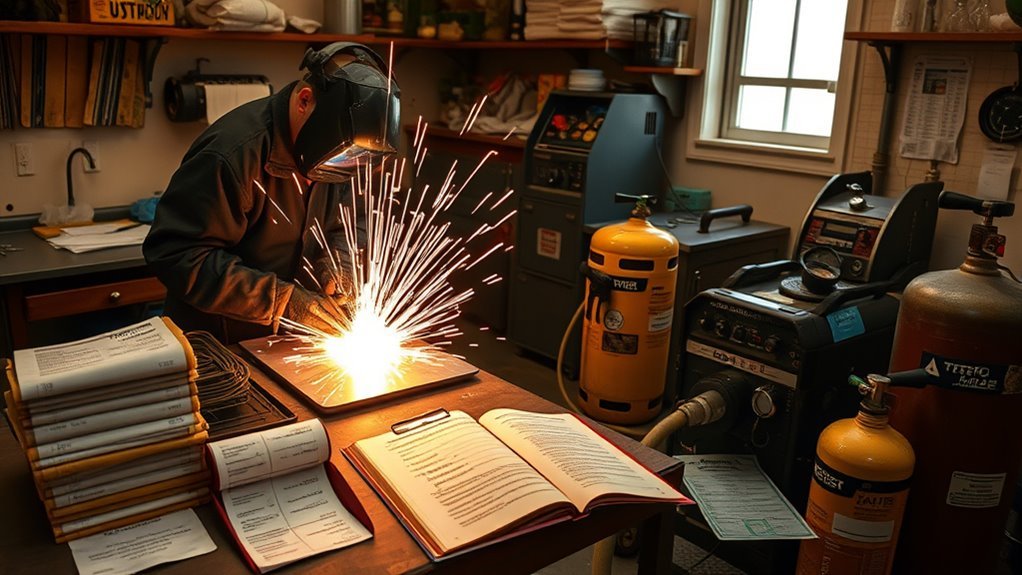You can spend a few thousand dollars or well into five figures for welding certification, and that gap tells you there’s more to evaluate than tuition alone. You’ll need to account for program type, tools, consumables, testing fees, and possible living costs. I’ll walk you through typical price ranges, certification exam costs, and ways to lower your outlay so you can plan a realistic budget.
Typical Tuition and Program Prices

One of the first things you’ll need to budget for is tuition: welding programs commonly run $5,000–$15,000, with specialized tracks like underwater welding often exceeding $15,000.
Budget for tuition—most welding programs cost $5,000–$15,000; specialized tracks like underwater welding often exceed $15,000.
You’ll evaluate welding program comparisons by credential: certificate programs typically cost $3,000–$10,000, diplomas $5,000–$15,000, associate degrees $10,000–$25,000, and bachelor’s programs $40,000–$100,000.
You’ll also record that certification test fees usually add $300–$550 per exam and may be billed separately from tuition. When you assess total cost, separate institutional tuition from ancillary charges to maintain clear accounting.
Use standard metrics—program length, credential level, and included testing—to compare value objectively. For many students, tuition financing options such as federal aid, institutional payment plans, vocational grants, and employer sponsorships will lower upfront outlay; verify eligibility and repayment terms before committing.
Maintain a concise cost matrix to guide final program selection.
Equipment, Materials, and Living Expenses

Start by itemizing the non-tuition costs so you can budget accurately: expect to spend $500–$1,500 on personal tools and safety gear (helmet, jacket, gloves, respirator, boots), $100–$500 on consumables like rods and wire, and $5,000–$15,000 per academic year for room and board if you’ll be living away from home.
Plan methodically: list required welding tools by certification level and prioritize certified, durable items that meet industry standards. Allocate a separate line for consumables and routine replacement of PPE; safety gear degrades and must be replaced on schedule.
For living expenses, create a monthly budget covering rent, utilities, food, transportation, and incidentals to avoid gaps during training. Track receipts and warranties to maximize lifespan and warranty claims.
If you qualify for financial aid, confirm whether it covers equipment or only tuition. By treating equipment, materials, and living costs as fixed elements of your training plan, you’ll reduce surprises and maintain compliance with safety and quality standards.
Certification and Testing Fees

Certification and testing fees typically run between $460 and $520 per exam, and you should budget for retests and optional add-ons that raise the total cost.
You’ll encounter standard pricing—ASME IX and many AWS tests sit at about $460, while some specialized certifications push toward $520. Fees generally include required materials for the exam, so you won’t be surprised by basic supply charges during the test.
Plan for retest costs: some exams (for example AWS D1.1 positions) can charge up to $250 per position, while ASME IX retests are commonly around $120.
If you opt into facility or documentation upgrades—such as the AWS Accredited Test Facility (ATF) Upgrade—you’ll add roughly $155 to the base fee.
For efficient budgeting, align your test preparation with the specific certification processes you’ll use, document required positions, and schedule attempts to minimize costly repeat testing.
Financial Aid, Scholarships, and Payment Options

If you’re worried about upfront costs, don’t assume you must cover everything out of pocket; federal grants, low‑interest loans, and school‑specific scholarships can substantially lower what you pay for welding certification programs. You should systematically evaluate financial assistance sources, document eligibility, and apply early. Combine grants, scholarships, and loans to minimize net cost.
| Option | Typical source | Key feature |
|---|---|---|
| Federal grants | Government | No repayment |
| Low‑interest loans | Federal/private | Predictable monthly cost |
| School scholarships | Institutions | Targeted for welding students |
| Payment plans | Schools | Spread payments, often no interest |
| Pay‑as‑you‑go | Schools | No credit check, pay per module |
Use payment plans or pay‑as‑you‑go if you need cashflow flexibility; they often avoid interest and credit checks. Track award deadlines and coordinate multiple funding opportunities to guarantee coverage for tuition, materials, and testing fees. Apply methodically and keep records of awards and repayment terms.
Return on Investment and Career Outcomes

Because you’ve invested time and money to gain certified skills, you can expect clearer pathways to higher pay, steadier employment, and targeted roles that employers prefer.
Certification benefits translate to measurable outcomes: the median annual wage for welders was $47,540 (May 2022), and certified technicians frequently command premiums above that baseline. Employers often require credentials for specialized roles—underwater, aerospace—so your certification directly expands eligible job pools.
You’ll also gain job stability; certified welders move into supervisory or specialized positions more often because standards-based credentials verify competence.
Treat additional certifications as a methodical strategy: each adds validated skills that improve bargaining position and enable career advancement. Track returns by comparing training cost and lost wages against incremental salary increases and promotion timelines.
Maintain certified status and pursue continuous learning to sustain long-term ROI. The outcome is predictable: documented skills reduce hiring friction, increase pay potential, and create structured pathways for advancement within industry standards.
Frequently Asked Questions
Are Prerequisite Skills or Certifications Required Before Enrolling?
Yes — you’ll often need welding prerequisites like basic math, metallurgy awareness, and shop safety; many programs list certification requirements such as OSHA safety training, prior coursework, or entry-level welding tests to confirm readiness before enrolling.
How Long Do Welding Certification Programs Typically Take?
Welding course duration typically spans weeks to months; program completion time often ranges from 8–52 weeks depending on level, intensity, and certification scope, and you’ll follow methodical, standards-focused training and assessed skill milestones.
Can Credits Transfer Between Welding Schools or Programs?
About 60% of programs accept some credits; you can often transfer them if you follow credit transfer policies and inter program agreements. You’ll need official syllabi, competency records, and supervisor verification to meet strict standards.
Are Online Welding Courses Accepted for Certification Exams?
Yes — you can use online course effectiveness to prepare, but you’ll need hands-on hours to meet certification exam requirements; verify the program documents practical training and aligns with the certifying body’s performance and testing standards.
What Safety Certifications Are Included With Training?
You’ll receive welding safety basics, PPE training, hazard communication, respirator fit, hot work permits, fire prevention, and OSHA-aligned practices; certification programs methodically document competencies, refresher requirements, and recordkeeping to meet industry standards and audits.
Conclusion
You’ll need to budget carefully: tuition typically runs $5,000–$15,000 (specialties higher), testing adds about $460–$520 per exam, retests up to $250, and tools/consumables $600–$2,000 total. Think of certification like sharpening a blade—one student spent $8,500 and emerged with skills that cut through job barriers, recouping costs within a year. Plan methodically, pursue aid or payment plans, track expenses, and treat each step as a measurable investment in your career.


